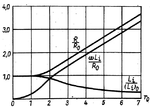CataM
Advanced Member level 4

- Joined
- Dec 23, 2015
- Messages
- 1,275
- Helped
- 314
- Reputation
- 628
- Reaction score
- 312
- Trophy points
- 83
- Location
- Madrid, Spain
- Activity points
- 8,409
Hi everyone,
I am talking regarding the design of the windings of a high frequency transformer. The point is to see whether or not using round untwisted conductors can get rid of the expensive Litz wire.
The optimization parameter then is the DC resistance.
It is known that due to skin effect (proximity effect between windings neglected because of the assumption of good interleaving) the AC resistance increases proportionally with the DC resistance of the winding.
For example, when the width of the equivalent rectangular winding "h" is much grater than the skin depth "δ" (h>>δ), the AC resistance has the following form (for the sake of simplicity, assume h~diameter "D" of a round conductor):
RAC=RDC*h/δ=ρ*length*4/(Π*D*δ)
As is seen, the bigger the wire, the lower the DC resistance is => the lower the AC resistance is. (D>>δ which is against the usual approach)
The downside is that as the harmonics frequency increase, the AC resistance increase because of the further reduction in skin depth.. but this is up to a certain point because the RMS current of the harmonics decrease as the frequency increase.
In conclusion, I would say this method could be a cheap alternative to the expensive Litz wire for cases where the harmonics of the current decrease below "1" in a "few" harmonics numbers. The "few" number needs to be decided according to the "h/δ" ratio and the decrease in harmonics amplitude rate.
For the case where the harmonics amplitude takes a long time to decrease below "1", the usual wire diameter selection according to skin depth should be chosen in order to prolong the number of current harmonics with amplitude>1 where Rac~Rdc.
-I would like to hear your opinion about this since this looks like a savage idea
-Did anyone experience transformers with unusually big thickness for the operating frequency they were working at ?
Thank you for your time !
I am talking regarding the design of the windings of a high frequency transformer. The point is to see whether or not using round untwisted conductors can get rid of the expensive Litz wire.
The optimization parameter then is the DC resistance.
It is known that due to skin effect (proximity effect between windings neglected because of the assumption of good interleaving) the AC resistance increases proportionally with the DC resistance of the winding.
For example, when the width of the equivalent rectangular winding "h" is much grater than the skin depth "δ" (h>>δ), the AC resistance has the following form (for the sake of simplicity, assume h~diameter "D" of a round conductor):
RAC=RDC*h/δ=ρ*length*4/(Π*D*δ)
As is seen, the bigger the wire, the lower the DC resistance is => the lower the AC resistance is. (D>>δ which is against the usual approach)
The downside is that as the harmonics frequency increase, the AC resistance increase because of the further reduction in skin depth.. but this is up to a certain point because the RMS current of the harmonics decrease as the frequency increase.
In conclusion, I would say this method could be a cheap alternative to the expensive Litz wire for cases where the harmonics of the current decrease below "1" in a "few" harmonics numbers. The "few" number needs to be decided according to the "h/δ" ratio and the decrease in harmonics amplitude rate.
For the case where the harmonics amplitude takes a long time to decrease below "1", the usual wire diameter selection according to skin depth should be chosen in order to prolong the number of current harmonics with amplitude>1 where Rac~Rdc.
-I would like to hear your opinion about this since this looks like a savage idea
-Did anyone experience transformers with unusually big thickness for the operating frequency they were working at ?
Thank you for your time !








